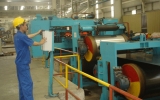Inflation: only one year less than 10 percent
Reviewing statistics of Vietnam’s inflation in the last five years, it is worrying that the consumer price index (CPI) in four years is over ten percent. The only one year with one-digit CPI is 2009 (6.5 percent).
This week the government will discuss solutions to curb inflation and stabilize macro-economics at its October meeting. VietNamNet reviews Vietnam’s inflation in the last five years.
Vietnamese people and businesses seem to be very familiar to high inflation because the CPI in September 2011 is 16.63 percent more than that of December 2010. The growth of CPI in Vietnam is alarming in comparison with that of its neighbors like Thailand, Malaysia and Singapore.
It is more worrying to know that in the last five years, only 2009 had the CPI with one digit. In the remaining years, the CPI is over ten percent, specifically: 12.6 percent for 2007, 19.9 percent for 2008 and 11.8 percent for 2010. This year, it would be lucky if the CPI is kept at 18 percent, because it is already over 16 percent by September.
According to the International Monetary Fund (IMF), the average CPI growth in 2007-2010 of newly-emerging and developing economies is 6.5 percent, 9.2 percent, 5.2 percent and 6.2 percent, respectively. That of developing countries in Asia is 5.4 percent, 7.4 percent, 3.1 percent and 6 percent, respectively. It is much lower for developed countries: 2.2 percent, 3.4 percent, 0.1 percent and 1.6 percent. Vietnam’s CPI in the last five years is ashamed records.
High inflation in Vietnam is always explained by the fluctuation of the international market. Recently, the method to calculate basic inflation has been cited in a bid to reduce CPI. Using this method, the State Bank of Vietnam and the General Statistic Office defined that Vietnam’s CPI in December 2010 is 9.92 percent, equivalent to 84 percent of the common CPI, if food is excluded. If energy is excluded, basic CPI is 9.81 percent, equivalent to 83 percent of the common CPI. If other non-monetary factors are excluded, Vietnam can be glad to announce that the basic CPI is even much lower.
In a recent report on high inflation in recent year, compiled by the Ministry of Planning and Investment, the ministry analyzed reasons as follows:
Regarding the monetary and credit policy: the money supply in recent years was “loosened”. Money supply increased more higher than the increase of gross domestic product (GDP) in a long time. The monetary growth (M2) is 43.7 percent, credit growth is 53.9 percent in 2007. This is the record high level in the 2001-2011 period, which is considered as one of the biggest reasons causing high inflation in 2008.
In 2009, the situation repeated, but at lower level than 2007, but it still caused high inflation in 2010 and 2011. The tightened monetary and fiscal policy as of early 2011 has worked, resulting in the reduction of inflation speed, which reached the peak in Apirl 2011 and has gradually reduced (in September, CPI grew 0.82 percent, the lowest level so far this year).
Strong devaluation of the Vietnam dong in recent years has also caused inflation and inflation expectation. The US dollar has depreciated in comparison with other currencies in recent years but in Vietnam, the Vietnam dong has depreciated against the US dollar.
The fiscal policy is also a reason. Overspending in this period is always over 5 percent (except for 2008 with 4.6 percent). If government bonds are included, overspending is much higher.
Constant overspending has forced the government to mobilize capital from the people through issuing bonds, treasury bills, which contributed to push up interest rate, total demand and pricing.
Another reason is the increase of input cost in the world. In 2008, the price for imported materials increased by 27.1 percent on average, pushing Vietnam’s average CPI to 22.97 percent. It rose 9.59 percent in 2010 and 18.32 percent in the first half of 2011.
According to the Ministry of Planning and Investment, ineffective economic and investment structure is the fundamental reason that cause unstable macro-economic balances and promote high inflation. The economy that develops in the width, mainly based on the increase of investment capital, outdated technology, with low investment effectiveness has made impacts on inflation.
Besides the above reasons, the ministry also mentioned other reasons, including a poor distribution system, natural disasters and epidemics, etc.
The Ministry has suggested 12 solutions to curb inflation and stabilize macro-economics. Notably, the ministry proposes to continue tightening the monetary policy but ensuring sufficient capital supply for agricultural, electricity production and for producing export goods; strictly controlling the gold, foreign currency market and restructuring commercial banks.
Other long-run solutions suggested comprise: restricting the economy and investment structure to improve macro-economic balance, cutting down budget deficit, maintaining government debts at safe level and gradually reducing government spending in the total investment.
Vietnamnet/ Manh Quan
- Promising breakthrough with strategic planning vision (22/07)
- Vietnam, Brazil promote cooperation in potential fields (21/07)
- Measures suggested to boost startups’ access to capital (21/07)
- Economic linkage belts throughout southern region necessary: insiders (20/07)
- Binh Duong well implement assistance of loans to people of poverty and social privileges (20/07)
- Binh Duong Young Entrepreneurs Association looks for business connection opportunities (20/07)
- Vietnam, Cambodia boost forestry cooperation (19/07)
- Enterprises in Binh Duong ready for double transformation (18/07)
 Promising breakthrough with strategic planning vision
Promising breakthrough with strategic planning vision
 Economic linkage belts throughout southern region necessary: insiders
Economic linkage belts throughout southern region necessary: insiders
 Binh Duong Young Entrepreneurs Association looks for business connection opportunities
Binh Duong Young Entrepreneurs Association looks for business connection opportunities
 Enterprises in Binh Duong ready for double transformation
Enterprises in Binh Duong ready for double transformation
 Ben Cat Town’s disbursement rate of public investment capital reaches 67.72%
Ben Cat Town’s disbursement rate of public investment capital reaches 67.72%
 Work starts on the most modern goods sorting center in Southern region
Work starts on the most modern goods sorting center in Southern region
 Phu Giao District strengthens promotion and connection of agricultural product consumption
Phu Giao District strengthens promotion and connection of agricultural product consumption
 Dual transformation - A sustainable development trend
Dual transformation - A sustainable development trend
 Driving forces created readily for development of logistics
Driving forces created readily for development of logistics
 Efforts made to help firms deeply join global semiconductor supply chain
Efforts made to help firms deeply join global semiconductor supply chain






